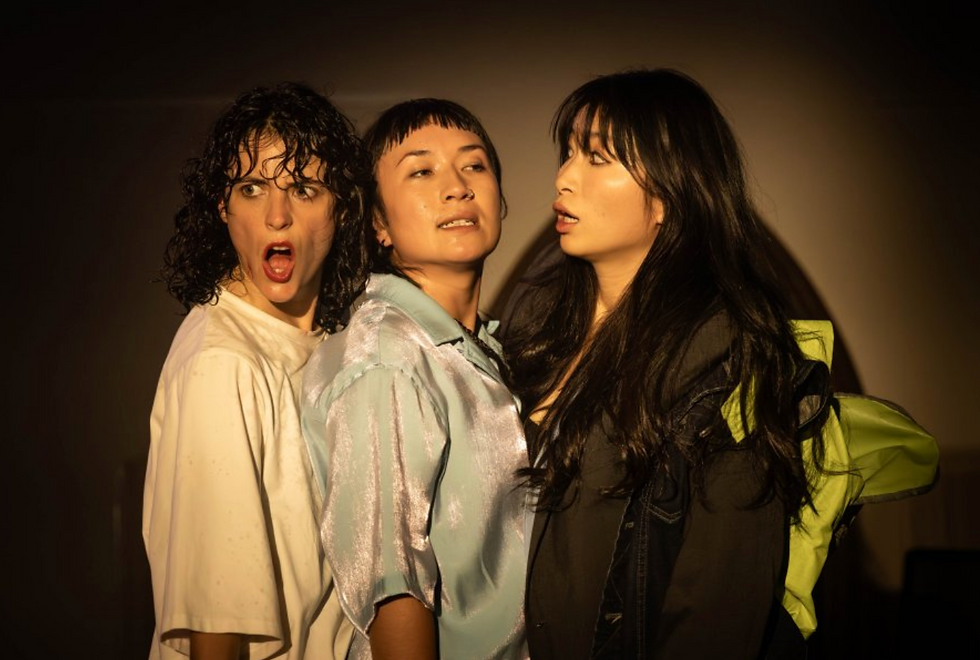Review: From All Who Came Before at La Mama HQ
- Theatre Travels

- Feb 9, 2022
- 4 min read
Review by Greta Doell It was a big night. After initial panic and despair at the news of the fire, then months of fundraising and construction, the newly rebuilt La Mama HQ finally staged its first show last night. Whilst the space is renewed, it’s still the same La Mama. As we were led into the new theatre, for the premiere of From All Who Came Before as part of the Midsumma festival, I could see previous parts of the space, that to me were iconic La Mama nooks and crannies, had been kept. The black brick walls, with several doors camouflaged into them, were back. The same staircase at the back wall of the space led down onto the stage, where various props and set pieces awaited the performers. The theatre was as intimate as ever- a blank page for all creative minds and viewers to project onto. The same can be said for the show itself. Devised and performed by Milly Cooper and Ben Jamieson of Wielding Theatre, From All Who Came Before was dreamlike. It followed the story of Loom, played by Milly Cooper, Avery played by Ben Jamieson, and Coda. The character of Coda was fascinating- their physical form on stage is a puppet, made of bamboo and cardboard. They are all torso, with a sculpted cardboard head, and a squeaky trolley for legs. Their story begins at a funeral, where just Loom and Avery speak. They are distanced, struggling to be around each other after being left behind in this world by Coda. The audience is then guided, back in time, through moments of the characters’ friendship. These moments are constructed through a Queer lens, using movement sequences and objects that hold endless meaning. The three reflect on what and who came before, questioning each other along the way- sometimes playfully, other times desperately. They create art together. They feel their way through the everyday. There is a literal guide through this - Coda is the narrator that describes the action on stage via embed Audio Description. But let there be no doubt, this audio description is a creative tool. The voice over narration of Coda, played by Kristen Smythe, is mesmerizing. Her expression is gripping- soothing yet foreboding at times. Occasionally this narration overlapped, muffled and faded, for valid creative and dramaturgical purposes. But this is worth noting, as it resulted in a tactile tour that was much more interpretive than I had experienced before. If an audience member was solely relying on this audio description, due to vision impairment or blindness for example, for small portions of the show they wouldn’t have had the most precise, literal descriptions of stage movements. Rather, the action and sound merged and jumbled to reflect the character’s psyches as the world around them blurred. Through this narration via audio description, as well as Cooper and Jamieson’s operation of the puppet, we see that Coda has always been the nucleus of the group. They are intangible yet present, omniscient but also trying to make sense of life just like Loom and Avery. Whilst it was an effective tool for characterisation, the audio description did at times seem to box the performers in, with moments of instinctual reactions and impulses seeming slightly restrained, so as not to clash with the timing of the audio narration. Jamieson and Cooper’s captivating use of repetition and gesture throughout movement sequences gave their characters complexity and punctuated evocative moments much more effectively than the dialogue. Their successful collaboration and chemistry as performers was clear through their ability to elicit so much meaning from even the smallest of movements. This occurred when they were together, but even when they were physically apart on stage they still worked fluidly together, ever connected. The dialogue also felt dreamlike, sometimes effectively, other times not as much.
There were moments where we were able to appreciate the characters’ honesty in their grief, or their joy in their moments of connection. One such moment was when Loom and Avery splayed on the floor, their legs up against the stage wall. They talked, pondered, shot grapes out of their mouths and enjoyed each other’s company. At other times the dialogue felt constructed, made up of the poetic prose, philosophical statements, and charged questions. It felt overwhelming at times, like when you’re in a dream and a character will just state something at you, prodding you and jumping around in the conversation rapidly. Whilst this slightly alienating affect seemed intentional, it was at times excessive when we wanted to be grounded in more of the characters’ pivotal, emotional moments.
The piece’s composition by Rachel Lewindon and Samuel Kreusler shines through. It serves all the different moments well through its simplicity, but it is not plain. Muffled voices and gentle instrumental soundscapes work into the sound design. They have a tranquil, muted quality, reflecting one of the play’s themes of disconnection and the characters’ tangled thoughts. The creator’s note mentions that the show was born from a visit to NGV’s Triennial, where the creators saw Joseph Wright’s 1781 painting ‘The Synnot Children.’ This source of inspiration makes the show – it’s moments all differ and take on a life of their own, brimming with meaning, like varying pieces in an art gallery that all follow the common thread of these characters’ connection. From All Who Came Before is a navigation through an ethereal world, which highlights the underlying beauty in the simplest of interactions and objects. Its uniqueness and rumination on the bonds of friendship make it worth adding to your viewing list of Midsumma shows.

Image Supplied




